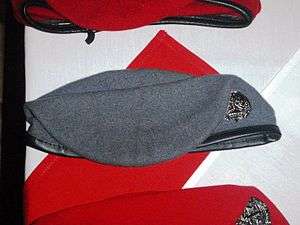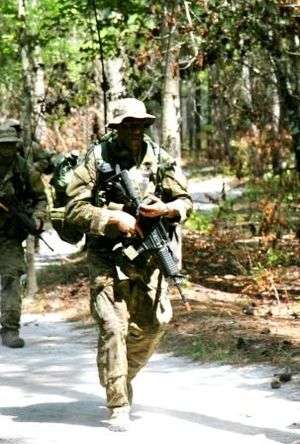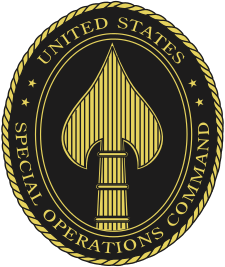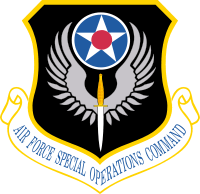United States Air Force Special Operations Weather Technician
| U.S. Air Force Special Operations Weather Team | |
|---|---|
|
U.S. Air Force Special Operations Weather Team Insignia | |
| Active | Yes |
| Country |
|
| Branch |
|
| Type | Special Operations Force |
| Role | Meteorology |
| Part of |
|
| Motto(s) | "Eyes Forward"[1] |


Special Operations Weather Team (SOWT) (AFSC 1W0X2) specialists are tactical observer/forecasters with ground combat capabilities and fall under the 720th Special Tactics Group within the Air Force Special Operations Command (AFSOC). The mission of a Special Operations Weather Team Specialist is to deploy by the most feasible means available into combat and non-permissive environments to collect and interpret meteorological data and provide air and ground forces commanders with timely, accurate intelligence. They collect data, assist mission planning, generate accurate and mission-tailored target and route forecasts in support of global special operations, conduct special weather reconnaissance and train foreign national forces. SOWTs provide vital intelligence and deploy with joint air and ground forces in support of direct action, counter-terrorism, foreign internal defense, humanitarian assistance, special reconnaissance, austere airfield, and combat search and rescue.
History
During World War II, Army Air Forces combat weathermen supported the American effort against the Japanese in the China-Burma-India theater of operations. They also participated in the European theater at Normandy Beach, France; and in the Netherlands and Yugoslavia.
However most of the special operations weather lineage, honors, and heraldry origins of WWII are attributed to the 10th Weather Squadron, at New Delhi, India under the 10th Air Force. The 10th Weather Squadron was constituted 10th Weather on 15 Jun 1942 and activated on 24 Jun 1942 (New Delhi, India). Inactivated on 3 Jul 1946 the 10th Weather Squadron was subsequently activated on 1 Jun 1948, inactivated on 20 May 1952, activated on 16 Jun 1966, organized on 8 Jul 1966, inactivated on 30 Sep 1975, designated 10th Combat Weather Squadron and activated on 1 Apr 1996, and finally inactivated 7 May 2014. The inactivation of the 10th Combat Weather Squadron resulted in special operations weathermen from the unit being integrated into 720th STG.
The various regional conflicts escalating in Southeast Asia during the years 1961 thru 1975 were causal for reactivating the 10th Weather Squadron on 8 July 1966 at Udorn Royal Thai Air Force Base in Thailand, to conduct combat weather operations in Southeast Asia. The 10th subsequently relocated to Long Binh AI, RVN, 3 Aug 1967 and then to Nakhon Phanom, Thailand, 18 February 1974 before being inactivated 30 June 1972. The squadron trained indigenous weather personnel and set up the clandestine weather observation networks throughout Southeast Asia. The 10th Weather Squadron played an important part in the raid on the Son Tay POW camp (a.k.a. Operation Ivory Coast) of 1970. The weather forecasting for this mission primarily relied upon images obtained from Defense Meteorological Satellite Program (DMSP) satellites, data obtained by weather aircraft reconnaissance sorties, and extensive climatic analysis data. Weather forecaster Major Keith R. Grimes who as Lt Col became the commander of the 10th during the period from 7 July 1974 to 15 Jul 1975 was weather advisor to the Joint Task Force Commander planning Operation Ivory Coast. It is Major Grimes' extensive work with climatological data and forecasts prepared by Air Weather Service personnel credited by Air Weather Service historians as setting raid's general date.
Previously during 1963 and 1964 then Captain Keith R. Grimes organized the first ad-hoc Air Weather Service Unconventional Warfare Detachment at Hurlburt Field, FL, during 1963 and 1964. These few in member numbers special warfare weathermen began deploying to Laos with primary mission training friendly forces to take and report weather observation. It was this small in numbers group of weathermen who worked clandestinely in Laos, under dangerous conditions and on a nearly uninterrupted basis, to establish and maintain a weather observing and reporting net essential to combat air operations. Posing as civilians with varying cover stories and carrying only a civilian identification card functioned not only as weathermen and advisors, but as forward air controllers, intelligence gatherers, and fighters. By 1972 the Air Weather Service had twenty-seven jump qualified combat weather team weathermen. Most were assigned in support of the XVIII Airborne Corps, or the 82d and 101st Airborne Divisions, but others were assigned with the 7th Weather Squadron in Germany and eight were assigned with the 5th Weather Wing's Detachment 75 at Eglin AFB's Hurlburt Field in support of Air Force and Army Special Forces. From 1972 to about 1985 parachutist qualified combat weather teams and special operations weather teams were considered nonessential. The prevailing senior leadership attitude during this period was expressed by a question AWS chief of staff, Colonel Edwin E. Carmell hypothetically asked in December 1972 of "If you look at it objectively, what kinds of weather [data] do you get out of those guys?" in referring to Detachment 75. "I think the answer is pretty clear," he continued: "they aren't needed."
The decisive origins of Special Operations Weather becoming a unique separate career weather Air Force Specialty Code having a specialty description is the 1 October 1996 reactivation of the 10th Air Weather Squadron as the 10th Combat Weather Squadron (10th CWS) and assigned to the 720th Special Tactics Group (720th STG) of the Air Force Special Operations Command (AFSOC). On 5 May 2008, the Air Force approved the establishment of a new Air Force Specialty Code for Special Operations Weather, formally recognizing their commitment to deploy into restricted environments by air, land or sea to conduct weather operations, observe and analyze all environmental data. The 10th Combat Weather Squadron was inactivated 7 May 2014 with special operations weathermen from the unit being integrated into the Special Tactics Croup, Wing and Squadrons.
Special operations weathermen were not included in the failed US embassy hostage rescue attempt in Iran in 1980, known as Operation Eagle Claw. A review group composed of six senior military officials (Admiral James L. Holloway III, United States Navy, Retired; Lieutenant General Samuel v. Wilson, United States Army, Retired; Lieutenant General Leroy J. Manor, United States Army Retired; Major General James C. Smith, United States Army; Major General John L, Piotrowski, United States Air Force, Major and General Alfred H. Gray, Jr., United States Marine Corps) released a report titled "Rescue Mission Report, August 1980" on Saturday, 23 August 1980. Issue 15 Weather Reconnaissance (pages 40 and 41) of the report discusses the ability of the Joint Task Force’s weather team (The AWS team was assigned to the JTP J-2 section) to accurately and reliably forecasting Iranian weather particularly along the 200 nautical mile helicopter route is discussed. The report asserts "in hindsight" more timely and accurate weather data could and should have been obtained from a WC-130 reconnaissance sortie scouting the route ahead of the helicopters which would have encountered the dust phenomena before the helicopters and forwarded this info to the helicopters. However immediately following the "hindsight" suggestion is disclosure OPSEC risks of such WC-130 pathfinder reconnaissance potentially causing mission compromise was considered to override any advantages gained. Regardless this working group’s assessment for direct weather causals for mission abort and the Desert One tragedy was insufficient and inadequate command and control combined with lack of precise weather abort criteria being determined during mission planning for mission aircrews to rely on in the absence of positive command and control.
Special operations weathermen have directly participated in the majority of modern special operations contingency operations since Operation Urgent Fury, the U.S. invasion of Grenada working with other special operations and conventional forces. These recent successes include operations Just Cause in Panama, Desert Shield/Desert Storm, Task Force Ranger operations in Somalia, Uphold Democracy in Haiti, operations in Bosnia and counter narcotics operations in South America, as well as ongoing operations in support of Enduring Freedom and Iraqi Freedom.
- 15 May 1942—Parachute School is established at Fort Benning, Georgia. It is a three-week course students attend en route to their duty assignment.
- 24 June 1942—Combat weathermen support the American effort against the Japanese in the China-Burma-India theater of operations.
- June 1944—Combat weathermen see action during World War II at Normandy Beach, France; and, in the Netherlands and Yugoslavia.
- 16 June 1966—The inactivated (20 May 1952) 10th Weather Squadron is reactivated. It is reconstituted and assigned on 8 July 1966 at Udon Airfield, Thailand to conduct combat weather operations in Southeast Asia. The squadron is responsible for training indigenous weather personnel and setting up the clandestine weather observation networks throughout Southeast Asia.
- November 1971—Timing for the Son Tay Raid was based on the three-day forecast. However much of the preliminary weather planning deciding when to best do the raid was accomplished in the United States by Major, subsequently Lt Col, Keith R. Grimes on a temporary duty assignment basis to from May 1970 until January 1971. During this period he was a faculty member of the Air Command and Staff College. He arrived in Southeast Asia at Tan Son Nhut on 10 November 1970. He subsequently personally selected and obtained two 1st Weather Group weather forecasters (Senior Master Sergeant Van Houdt and Master Sergeant Ralston) to do the mission forecasting. The weather forecasting for the actual raid mostly relied on weather satellite data and data from numerous aerial weather reconnaissance sorties that were flown daily to include the day of the raid. The weather support personnel successfully used data from weather satellites (DMSP products) and data from aircraft weather reconnaissance sorties to forecast the only 12 hours of "go" conditions during a 38-day period.
Training
To qualify for entrance to SOWT training, recruits must be able to swim 500m in 11:42, perform 10 pull ups in 60 seconds, 48 push ups in 2 minutes, 52 sit ups in 2 mins, run 1.5 miles in 10:10 and ruck march 4 miles in 60 mins with 50lbs in battle dress uniform and boots all after swimming 2x25m underwater. Should applicants surface, pass out or not finish both times they are unable to even begin SOWT training.
They maintain the same weather weapon system qualifications as all Air Force weathermen in addition to advanced special tactics skills. Their 2.5 to 3 years of training and unique mission skills earn them the grey beret. Previously, only those who were already in a weather-related specialty were recruited for training, but on 5 May 2008, the Air Force approved the establishment of a new Air Force Specialty Code for Special Operations Weather, formally recognizing their commitment to deploy into restricted environments by air, land or sea to conduct weather operations, observe and analyze all weather data and environmental intelligence.
Initial Training
- Special Operations Weather Selection Course, Lackland Air Force Base, Texas (two weeks)
This course focuses on sports physiology, nutrition, basic exercises, special operations weather history and fundamentals.[2]
- Special Operations Weather Initial Skills Course, Keesler Air Force Base, Mississippi (30 weeks)
This course prepares special operations weather apprentices. Training includes basic, intermediate, and advanced meteorology, report writing and computer usage. Other topics include satellite meteorology, weather chart analysis, weather radar, weather products, tropical meteorology, synoptic level analytical meteorology, weather prognosis techniques, forecasting weather elements to include severe weather, synoptic lab, forecasting lab, and a unit on the weather career field and weather equipment. Additionally, this time is also used to train students physically and mentally for the rigors of the rest of their pipeline. Students train alongside combat controllers to develop the team mindset they will use during their career.[2]
- Army Airborne School, Fort Benning, Georgia (three weeks)
Trainees learn the basic parachuting skills required to infiltrate an objective area by static line airdrop.[2]
- Air Force Basic Survival School, Fairchild Air Force Base, Washington (2.5 weeks)
This course teaches basic survival techniques for remote areas. Instruction includes principles, procedures, equipment and techniques, which enable individuals to survive, regardless of climatic conditions or unfriendly environments and return home.[2]
- Air Force Water Survival Training, Fairchild Air Force Base, Washington (two days)
This two-day course teaches principles, procedures, techniques, and equipment that enhance the ability to survive in a water environment and return to friendly control.[2]
- Air Force Underwater Egress Training, Fairchild Air Force Base, Washington (one day)
This course teaches the principles, procedures, and techniques necessary to successfully egress from a sinking aircraft. Experiencing water entry and performing underwater egress is part of the training.[2]
- Special Operations Weather Apprentice Course (Combat Control School), Pope Field, North Carolina (13 weeks)
This 13-week course provides final special operations weather qualifications. Training includes physical training, austere weather operations, tactical weather observations, small unit tactics, land navigation, communications, demolitions, and field operations including parachuting. Upon completing the course graduates are awarded a 3-skill level (apprentice), gray beret and SOWT crest.[2]
- Special Tactics Training Squadron, Hurlburt Field, Florida (12–15 months)
This four phase course, formal training, core tasks, employment readiness training, and operational readiness training, produces operators ready for deployment as special operations weathermen
- Core Training Available During Operational Duty
The following is a list of schools which are available to certain SOWT candidates based upon the needs of their unit and the Air Force: Riverine Assessment, Avalanche Forecast, Military Freefall (HALO/HAHO), SCUBA, Small Unmanned Aerial Systems (SUAS), Pathfinder, RSLC, and numerous ground combat specialty courses [2]
Mission

Special Operations Weathermen are U.S. Air Force meteorologists with unique training to operate in hostile or denied territory. They gather, assess, and interpret weather and environmental intelligence from forward deployed locations, working primarily with Air Force and Army Special Operations Forces. SOWTs can also be attached to Marine MARSOC and Navy SEAL teams. They collect weather, ocean, river, snow and terrain intelligence, assist mission planning, generate accurate mission-tailored target and route forecasts in support of global special operations and train joint force members and coalition partners to take and communicate limited weather observations. They operate on 2-3 man Environmental Reconnaissance Teams (ERT). ERT's are attached to 8-9 man Special Tactics Teams (STT) alongside Combat Control (CCT) and Pararescue (PJ) personnel. Together they provide SOCOM a unique capability to establish and control austere airfields in permissive and non-permissive environments. Additionally, Special Operations Weathermen conduct special reconnaissance, fly small unmanned aerial systems (SUAS), collect upper air data, organize, establish and maintain weather data reporting networks, determine host nation meteorological capabilities and train foreign national forces. Every Special Operations Forces mission is planned using the intelligence and coordination of special operations weathermen.
Notes
Special Operations Weather Team members were known as Air Commando Weathermen in the 1960s, and Special Operations Weather Team members through the 1970s and 1980s. They were known as Combat Weathermen until the late 1990s when base weather stations were "redesignated" as Combat Weather Teams (CWT). This caused quite a bit of confusion and prompted the name change from Combat Weatherman to Special Operations Weather Team specialists. Today's Combat Weather Teams typically provide front-line combat weather support to regular Army, Navy, Marine, Air Force, and Coast Guard units and their members receive combat training depending on the types of units they support.
Air Force special operations weathermen now have a new specialty code they can call their own.
Recruiters can enlist trainees directly into the 1W0X2 special operations weathermen career field since the new Air Force specialty code is now in the enlisted classification directory.
Before this new AFSC, weather Airmen applied to become special operations weather after already being in the Air Force. They were sent to work and live on Army post, where they relied on the Army for equipment and training. There was no standardized training, according to Chief Master Sgt. Andrew Hopwood, Air Force Special Operations Command weather functional manager.
"The new AFSC will provide special operations weathermen the right technical, physical and tactical training from day one. This will greatly enhance their battlefield observing, environmental reconnaissance and forecasting missions," said Chief Hopwood.
Because of time between classes, Airmen previously spent four years training to become special operations weathermen. Under the new program, they will finish training in approximately two and half years. The first Basic Military Training graduates enter the new training pipeline January 2009.
Trainees will attend the two-week Special Operations Weathermen Selection Course at Lackland Air Force Base, Texas. This is a physical training assessment with progressive training to prepare candidates for the next phase.
After the selection course, students will attend their initial skills course at Keesler AFB, Miss., for 30 weeks where they will go through the Air Force Weather Course and endure additional physical training elements.
Upon completion of their initial skills course, they will earn their jump qualification from Airborne school at Fort Benning, GA, and attend Survival school at Fairchild AFB, WA. They will then train side-by-side with combat controllers at the Special Operations Weather Apprentice Course at Pope Field, NC, before being assigned to the Special Tactics Training Squadron here. They will learn additional weather skills necessary to deploy and operate in stressful environments. Training will also include basic communication, navigation, employment techniques, weapons training and small unit tactics.
Special operations weathermen have now over 150 slots, but are currently only 65 percent manned. Once Airmen became special operations weathermen, they were assigned to Hurlburt's 10th Combat Weather Squadron and stationed at detachments across the United States. (The 10 CWS officially inactivated on 16 May 2014 and its personnel were integrated into the 720 STG.[3]) These assignments currently include:
Air Force Special Operations Command (AFSOC)
- 21 STS, Pope AFB, NC
- 22 STS, McChord Field, WA
- 23 STS, Hurlburt Field, FL
- 321 STS, RAF Mildenhall, UK
- 320 STS, Torii Station, Japan
Air National Guard (ANG)
- 123d Special Tactics Sq, Louisville, KY
- 125th Special Tactics Sq, Portland, OR
- 181st Weather Flight, NAS Joint Reserve Base Fort Worth, TX[4]
See also
- United States Special Operations Forces
- List of United States Air Force special tactics squadrons
- Air Force Weather Agency
- Military meteorology
References
- ↑ "Special Operations Weather Team Fact Sheet". Air Force Link. United States Air Force. October 2007. Archived from the original on 12 November 2008. Retrieved 23 November 2008.
- 1 2 3 4 5 6 7 8 "Special Operations Weather Fact Sheet". Air Force Special Operations Command. United States Air Force. October 2008. Retrieved 24 November 2008.
- ↑ http://www.afsoc.af.mil/News/ArticleDisplay/tabid/136/Article/495067/10th-cws-deactivates-at-hurlburt-field.aspx
- ↑ http://www.136aw.ang.af.mil/news/story.asp?id=123274262
External links
| Wikimedia Commons has media related to Air Force Special Operations Weather Team. |
- Official fact sheet
- Airforce.com profile
- Specialtactics.com
- Air Force Link Factsheet: Special Operations Weather Team at Archive.is (archived 2012-07-18)
- National Weather Association's Air Force Weather page – Good explanation of today's CWTs
- Feature on Air Force Link (Dec 2005) at Archive.is (archived 2012-12-12)
- ShadowSpear.com



